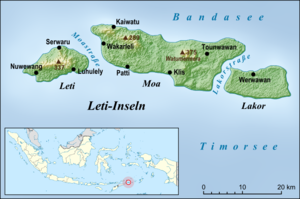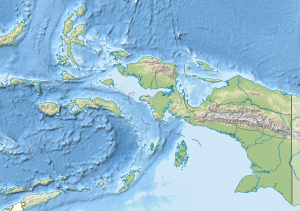Leti (island)
| Leti | ||
|---|---|---|
| The Leti Islands | ||
| Waters | Banda Sea , Timor Sea | |
| Archipelago | Moluccas | |
| Geographical location | 8 ° 10 ′ S , 127 ° 42 ′ E | |
|
|
||
| surface | 91.25 km² | |
| Residents | 7526 | |
| main place | Serwaru | |
| Traditional art by Leti | ||
The Indonesian island of Leti ( indon. Pulau Leti ) belongs to the Leti Islands ( southern Moluccas ).
geography
| Desa (villages) | ||
| Today's name | Population (2010) | old name according to Barchewitz |
| Tutuwaru | 380 | - |
| Batumiau | 1.007 | Battomea |
| Laitutun | 545 | Leyduttun |
| Tutukey with the main town Serwaru | 1,136 | Duttukey |
| Tomra | 2,433 | Domra |
| Nuwewang | 1,015 | Nuwewang |
| Luhulely | 1.010 | Liwelely |
Leti is the westernmost island in the Leti Islands. To the east lies the larger island of Moa .
The island consists of a triangular ridge bordered by the mountains Koli Besar in the east and Rapat in the west. Leti does not have a natural harbor. Due to the monsoons between December and April, it is completely cut off from the outside world, as the anchorages are then unusable.
Leti forms the district ( Kecamatan ) Leti Moa Lakor ( administrative district Maluku Barat Daya , province Maluku ), which is divided into seven Desa . Serwaru is the main town of the district and the island. It is located in Desa Tutukey in the north of the island. Desa Tomra is west of Tutukey , Batumiau east. Tutuwaru (Tutuaru) and Luhulely are in the south of Leti. The western tip of the island forms the Desa Nuwewang and the eastern tip Laitutun .
history
Artifacts from the Bronze Age have been found on Leti. They come from the Dong Son culture around 800 BC. BC to AD 200
At the end of the 17th century, the Dutch East India Company established a military base on Leti under the governor of Banda , similar to others on the Barat Daya Islands . On Leti, three soldiers had to ensure peace and order on the island. In addition, the commanding officer had to cut off contact between the local population and relatives in the Portuguese East Timor , forbid the cultivation of nutmeg trees on Leti, and procure labor (slaves) and beeswax for the provincial administration on Banda.
Ernst Christoph Barchewitz was the commanding officer of the Dutch East India Company on Leti from 1714 to 1720. In addition to flora and fauna, Barchewitz described in detail the customs and traditions of the Letinese. At that time, headhunting was still common, although some Letinese were Christians at the time.
At the beginning of the 18th century there were seven villages on Leti that still exist today. Local chiefs, so-called Orang Kaya (rich people) , ruled over five places . Serwaru was not subject to any orang kaya, while Batumiau was ruled by an orang kaya together with Laitutun.
Batumiau and Luhulely were founded by Dutch-friendly immigrants from the island of Luang . The villagers of Tutukey, Tomra and Nuwewang were friends of the Portuguese, who were the first Europeans on Leti. They were expelled from Leti by the Dutch with the help of the immigrants from Luang and Sermata .
Residents
7,000 people live on Leti Island. The Austronesian language Leti is spoken .
The Patumera family (Orang Patumera) on Leti, Moa and Luang were people from the legendary red stone Batumerah ( Indonesian : Batu = stone, merah = red), whose deceased were supposed to live on the island of Wegnau . The linguistic kinship with the population of Batumerah on Damar Island suggests that this gender could have come from there.
300 years ago, Letinese were quite tolerant of extramarital relationships. Cheating was not severely punished if it did not result in pregnancy. The perpetrators were charged with giving away valuables (plates, sarong, cow, pig, sheep and other items) to the betrayed spouse. The extent was dependent on the social status of those affected. In addition, the perpetrators had to pay fines to the mayor and the Dutch administrators.
Traditionally, there was a close trading relationship with the Fataluku from Tutuala in East Timor , which also led to a cultural exchange. East Timor is just a day's sailing away from Leti. A commodity were Batik - sarongs . However, since East Timor's independence in 2002, traditional trade across national borders has declined.
literature
- Ernst Christoph Barchewitz : East Indian travel description. His Eilff-year stay on Java, Banda and the Southwest Insullen, cases of luck and misfortune and strange occurrences ... , Chemnitz 1730, Liber II, Cap. X-XXXI, pp. 206-492
Web links
Individual evidence
- ↑ Penduduk Indonesia menurut desa 2010 ( Memento from March 27, 2014 in the Internet Archive ) (Indonesian; PDF; 6.0 MB), accessed on January 26, 2013
- ↑ a b Map of the Desas
- ^ Kümmerly + Frey Rand Mc Nally: Internationaler Atlas , Westermann, 1986, ISBN 3-14-106025-8
- ↑ a b c Indahnesia: The Leti Islands. In: indahnesia.com , accessed December 22, 2012
- ↑ M. Junus Melalatoa: Ensiklopedi Suku Bangsa Di Indonesia. Sejarah Suku Leti. ( online )
- ↑ Jeanne Brunk-Tan: An 18th century Erfurt citizen with an East Indian past. Barchewitz as commanding officer on the Forgotten Islands . In: City and History, magazine for Erfurt. March 2016, No. 62. pp. 12-14
- ^ Ernst Christoph Barchewitz: East Indian travel description , Chemnitz 1730, p. 248
- ^ Ernst Christoph Barchewitz: East Indian Travel Description , Chemnitz 1730, pp. 257-259
- ^ Ernst Christoph Barchewitz: East Indian Travel Description , Chemnitz 1730, pp. 314-316
- ↑ Svetlana F. Chlenova, Mikhail A. Chlenov: West Damar Language or Damar Batumerah to isolates in South-Eastern Indonesia. ( Memento of the original from May 12, 2015 in the Internet Archive ) Info: The archive link was inserted automatically and has not yet been checked. Please check the original and archive link according to the instructions and then remove this notice. (PDF; 94 kB)
- ^ Ernst Christoph Barchewitz: East Indian travel description , Erfurt 1751, pp. 254-257
- ↑ Lisa Palmer, Demétrio do Amaral de Carvalho : Nation building and resource management: The politics of 'nature' in Timor Leste. ( Memento of the original from February 1, 2014 in the Internet Archive ) Info: The archive link was inserted automatically and has not yet been checked. Please check the original and archive link according to the instructions and then remove this notice. (PDF; 343 kB) Accessed December 28, 2012





